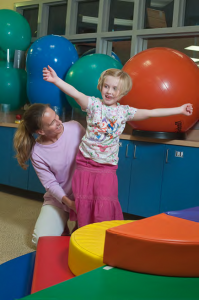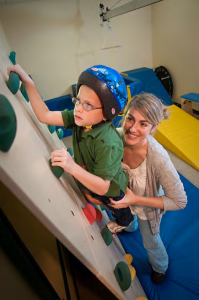The purpose of my project was to perform the groundwork for implementing a Pediatric Physical Therapy Residency Program at a large academic medical center. This included surveying potential future residents and clinical faculty, performing a gap analysis and identifying the resources required to implement the residency program, and completing the APTA Credentialed Residency Application. The APTA Credentialing Application is a four-part document focused on overall Organizational goals and objectives, Curriculum design, Resources available to the program, and Ongoing Program Evaluation.
Residency training for Physical Therapists allows physical therapists to train in a defined specialty area with formal mentoring and supervision by advanced clinicians, and advanced education and clinical training specific to specialty practice. Residency training provides a fast track for the development of clinical expertise and prepares the resident for APTA advanced specialty certification. Despite these benefits, there are only eight APTA Credentialed Pediatric Residency Programs in the country. My hope is that this project might serve as a template to others who are considering planning a residency program. I also hope to gain feedback from educators and future residents that will help us build a really valuable experience for residents. WF Residency Brochure
Surveying the Pediatric Physical Therapy Community
A short survey was developed and electronically distributed to third year DPT students, new graduate therapists and pediatric therapists pursing advanced specialty certification. The linked summary captures key themes that emerged from the survey. Survey Summary
Identifying the Resources required and asking for support from senior administrators
The next step in the process is identifying the upfront cost of the program and requesting administrative support for funding. Residency Programs more than cover their costs by the end of the first year, but there is an upfront investment of time to develop the curriculum, recruit residents, mentor and train residents and coordinate the program. In addition to time for faculty, residency salary and benefits and the costs associated with the credentialing process must be budgeted. A formal business plan outlining the benefits to the institution and the specific costs of the program with the return on investment was developed to support our budget request.
APTA Application Part I: The Organization
Part I of the APTA Application for Credentialing of Residency and Fellowship Programs outlines the overall institution’s mission and values and how these mission and values tie back to those of the Residency Program. Specific institutional and program policies and procedures are referenced. As a guide to the documents linked below, the credentialing process has many evidence requirements. Those are highlighted in bold. Of note, the formal credentialed process starts after successful enrollment of the first resident. If business plan is approved, we will enroll a resident in January 2013 and submit application for credentialed status at that time. WF Residency Program Organizational Overview, Policy on Program Roles/Responsibilities
APTA Application Part II: Curriculum
The document outlining the Pediatric Physical Therapy Residency Curriculum at a high-level is linked below. Residents will participate in clinical training in the Outpatient Pediatric Therapy Department (Module I), Brenner Children’s Hospital (Module II), and the Human Performance and Biodynamics Laboratory (one day a week throughout the year). Didactic education will include an Advanced Pediatric Physical Therapy Management course with Dora Sole, PT, DPT, PCS at Winston-Salem State University as well as regular case series presentations, lectures, Grand Rounds and discussions with our entire WFBMC Pediatric Interdisciplinary Team. WF Pediatric Residency Curriculum Overview
APTA Application Part III: Resources
The APTA requires that Credentialed Programs demonstrate evidence of sufficient clinical faculty, staff, financial, facility, patient population, and equipment resources to provide the specialty training program. The Resource document details the resources required to ensure success of the program Pediatric Residency Program Resources. Supporting documents include the Residency Program Director Job Description Program Director Job Description.
APTA Application Part IV: Ongoing Evaluation
The effectiveness of the Pediatric Physical Therapy Program relative to goals, objectives, curriculum content and flow, resident, mentor, and faculty performance will be evaluated on an ongoing basis. The Ongoing Evaluation Evidence Document is the forth part of the APTA application and outlines our process for this. Pediatric Residency Program Evaluation The process for evaluating the program’s effectiveness will include the resident’s formal feedback on clinical mentors Mentor Evaluation Form, academic instructors Instructor Form, and the overall Residency Program Program Evaluation Form. In addition, residents will participate in formal practical and written examinations. The attached is an example of the Outpatient Department of Physical Therapy Practice Guidelines for Serial Casting with corresponding written test. WFMBC Serial Casting Practice Guideline, Casting Competency Test Similar practice guidelines with corresponding examinations will be followed to assist with defining clinical competency in advanced practice areas such as orthotic and brace recommendations and management of pediatric incontinence.
Thank you for visiting my Capstone Project. Special thanks to my Capstone Project Committee: Terry Sink, Debbie Neeves, and my Capstone Advisor Karen McCulloch.




8 Responses to “Pediatric Physical Therapy Residency Program”
jlkowals
Susan,
Wow! This is incredible! I am in awe of all the work you have put into this and am so grateful that you chose to focus on this for your capstone. As a future practitioner who wants to pursue pediatrics, I cannot tell you how valuable I consider this program you have developed. I would love to be able to gain more knowledge and experience from a residency program such as this one. Absolutely phenomenal.
Jesse
tsink
Susan,
The presentation for the Pediatric Residency Program for your Capstone project reflects detailed consideration of the clinical, administrative and educational training needs a Pediatric PT practioner will need. This project is certainly a work you wanted to see happen and feel strongly about. Great inspiration for therapists at the facility and therapists considering the program for their residency!
Good luck and congratulations on a wonderfully presented and composed project.
Karen McCulloch
Susan, This looks awesome. It is fun to see pictures of Ashley and Heather – makes me want to apply to be a resident :). I think you’ve done great work and have thought of most everything that is necessary – this is an over the top capstone, but we are psyched that it is somethign that you’d been wanting/needing to do – what a perfect choice for a project. One thing I would consider for the brochure is to shrink text and include a bit more about the special features and experiences that the residency entails. Include more info about when you typically are looking for applications, when you decide, your ability to enroll and how long it takes, and how compensation works (not specific numbers but that they realize how many hours they are working and are paid accordingly) – to save you repetitive email responses.
You could even summarize common expereinces that residents will have – including a case study that could be submitted for presentation, etc….I think those outcome oriented things may have more appeal than reading global objectives that are more abstract….
Of course to meet the APTA qualifications there are set requirements, I get, but seeing how your group will have those play out and the special experiences you all offer than other residencies might not – that seems what you want in the brochure so you hook the interest from the start. I’m waiting on committee feedback still as the last step before I can sign off, so have them send me info when they can.
kmac
chhill
Susan,
Very impressive project! It is obvious how much time and effort went into planning this residency program. I like that you surveyed potential residents and revised the curriculum to meet interests. I also like your ability demonstrate to the hospital how its a win-win situation to add this program/position. Hope is works out!
Carla
Susan Reeves
Hi Leigh,
Thank you so much for your question. If the application is denied, we will receive a denial letter detailing the reasons for denial. We will have the opportunity to remediate and re-apply for credentialing at any time. This would allow us to become credentialed before the first resident graduates even if we are not successful with our first submission (of course this is not optimal as I assume that we would have to pay the credentialing application costs twice…we will definitely plan to be prepared the first time!)
If the program did not become credentialed, the resident would still be a candidate for ABPTS Pediatric certification under option A. Accruing the 2,000 hours of direct patient care might however take a little over a year.
Option A:
Applicants must submit evidence of 2,000 hours of direct patient care in the specialty area within the last ten (10) years. 25% (500) of which must have occurred within the last three (3) years.
Thank you for your comments and questions!
Susan
mlbunge
Susan, this is impressive! What a way to dream big and make it happen. I would have no idea how to go about the business part of designing a program like this. You are also well-versed in our profession’s mission for the residency program. I am proud that this could happen in our city! Hope to hear how it goes! Miranda
Susan Redmond
Great job, Susan! This is very comprehensive and obviously required alot of work. As a hiring manager, it is often difficult to find suitable candidates for specialized services, and with the demands of current environment, “OTJ” development is very challenging. I feel certain others will be able to use your work as a template to design other programs. This has the potential to be an excellent program. Good luck!
Leigh McLaughlin
Susan, your Capstone project shows that you have dedicated a considerable amount of time, planning, and hard work to the development of the Pediatric Physical Therapy Residency program. I enjoyed reading through all of your materials to better understand what the residency development process and a pediatric residency includes. I would encourage you to allow your future residents to view these same materials because it will provide a clear and comprehensive understanding of the residency program they are engaging in.
After reading through your materials I have a question I hope you don’t mind responding to. In order to apply for status as an APTA Credentialed Pediatric Physical Therapy Residency the program must have enrolled a resident. What is the result if the APTA Credentialing comes back denied for that year? Will the enrolled resident not be recognized as a having successfully completed a residency program and therefore be ineligible for specialist certification examination? I reviewed the APTA minimum eligibility requirements for physical therapist specialist certification examination which reads “Option B: Applicants must submit evidence of successful completion of an APTA-credentialed post professional residency in their respective specialty.” Have you entertained this possibility and what remedial action will take place in the event credentialing status is declined? Can the program quickly reapply or will you be limited to one resubmission per calendar year? Are residents who went through the program during non-credentialed years eligible for specialist certification examination once the residency has been credentialed?
Thank you for entertaining my question. Very good work on the planning and development stages of the Pediatric Residency program! Best of luck!